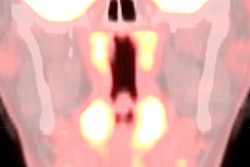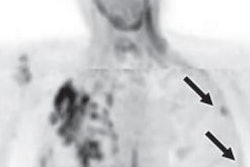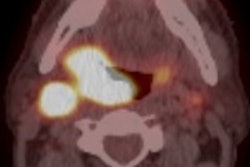Radiologists can help reduce unnecessary follow-up work in patients with suspected oropharynx cancer by analyzing certain metrics on PET/CT scans, according to a team of head and neck surgeons at the Mayo Clinic in Rochester, MN.
In an analysis of cases where F-18 FDG radiotracer uptake was reported as suspicious for oropharynx cancer on PET/CT scans, the number of patients who were actually diagnosed was low, the group found.
“While incidental asymmetric oropharynx PET uptake was common, a new diagnosis of oropharynx cancer was not and potentially results in a large volume of unnecessary referrals and work-up,” noted lead author Michael Armstrong, MD, and colleagues. The study was published August 29 in JAMA Otolaryngology-Head & Neck Surgery.
Incidental findings on PET/CT refer to accumulations of F-18 FDG radiotracer that radiologists report as suspicious for cancer yet that are unrelated to the primary reason for the scans. Asymmetric oropharynx tracer uptake on PET/CT is a common incidental finding, often due to nonspecific uptake of F-18 FDG in lymphoid tissue found in the throat, for instance, the authors explained.
These signs often prompt otolaryngology referral to rule out malignancy yet the true risk based on the finding is unknown, they noted.
To bridge this knowledge gap, the group analyzed 327 PET/CT diagnostic radiology reports between January 2001 and December 2018 at their institution that included descriptions of the finding.
Out of the 327 reports, the analysis found that a total of 18 patients (5.5%) were determined to have an incidental diagnosis of oropharynx cancer. Of the 18 patients, nine (50%) had squamous cell carcinoma, eight (44%) had lymphoma, and one (6%) had sarcoma.
Further analysis revealed that these diagnosed patients had higher F-18 FDG mean ipsilateral radiotracer uptake. Maximum standardized uptake values (SUVmax) were 8.7 versus 5.3 and SUVmax ratio was 3 versus 1.6 in these patients compared with patients with normal examination findings.
“The findings that ipsilateral SUVmax, SUVmax ratio, and SUVmax difference were predictive of a diagnosis of oropharynx cancer may help radiologists when interpreting PET/CT scans and considering making a referral to a head and neck oncologist,” the group wrote.
Future studies including larger sample sizes are needed to better understand optimal cutoffs for SUVmax ratio and SUVmax difference and to generate a risk assessment equation for predicting which patients are at highest risk, they suggested.
Ultimately, as the clinical use of PET/CT continues to expand, incidental radiographic findings are increasingly being identified, and this creates a dilemma in deciding whether to pursue further work-up of these findings or surveil them with additional imaging, the authors wrote.
“Although physiologic radiotracer uptake is common in the oropharynx, malignant neoplasms are not,” the group concluded.
The full article is available here.




















